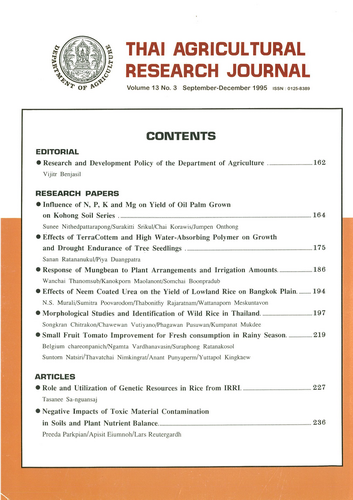Morphological Studies and Identification of Wild Rice in Thailand
DOI:
https://doi.org/10.14456/thaidoa-agres.1995.20Keywords:
wild rice, character variation, AA genome taxaAbstract
A total of 286 wild rice accessions were grown under experimental conditions at Pathum Thani Rice Research Center. In total, 48 characters were examined during 1991-1994. The objectives were to characterize and evaluate wild rice accessions collected in Thailand. It was found that accessions of the AA genome species and those of CC genome species (O. officinalis) showed different frequency distributions in 13 quantitative and 6 qualitative characters. Among them, seed size and ligule length may be used to discriminate the AA genome species from O. officinalis. On the other hand, O. rufipogon, O. nivara and spontanea forms exhibited almost the same variation range. Although some characters showed slight differences among the species, it was difficult to separate these species by these characters. To analyze multivariate variation in AA genome taxa, the principle component analysis (PCA) was conducted on a correlation matrix of 30 characters obtained from 232 accessions. The first component was found to represent mainly the size of vegetative organs while the second component might refer to the character variation in plant shape. The third component seemed to refer to the variation between wild and cultivated types. The accessions were plotted on the two-dimensional scatter diagrams based on the scores of the first three components. The results showed variation among accessions of Asian AA genome taxa is a continuous. It was not possible to make any distinct separation among the AA genome species. Yet, judging from the large loading values on the size of vegetative organs and longevity found in the first component, it may be said that the most principal variation found in these accessions is a variation between perennial and annual types, O. rufipogon and O. nivara, respectively. Three agronomically important characters, photoperiodic sensitivity, longevity (perennial/annual) and seed protein content were evaluated for 236 accessions. Among the AA genome samples, about 65% of accessions were perennial and 70% were photoperiodic-sensitive. In O. officinalis, 75% were photoperiodic-insensitive and 100% were perennial. Protein content analysis of wild rice seeds showed a large variation among accessions. Many accessions of O. rufipogon and Spontanea forms had a high amount of seed protein. They may serve as a source of germphasm for high protein content.
Downloads
Published
How to Cite
Issue
Section
License

This work is licensed under a Creative Commons Attribution-NonCommercial-NoDerivatives 4.0 International License.
Thai Agricultural Research Journal



